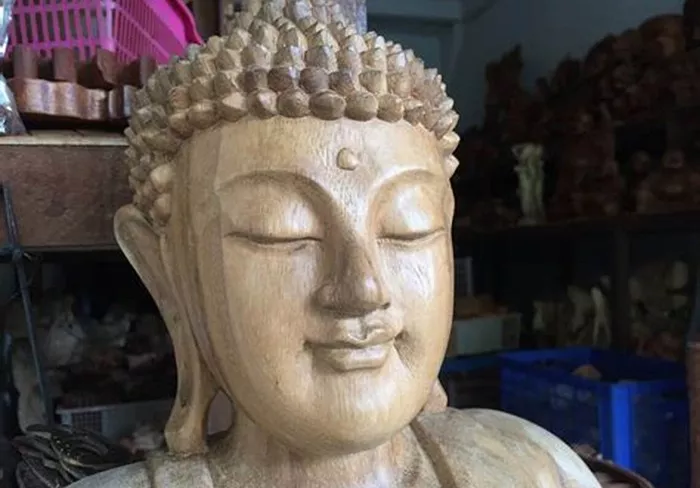Wooden Buddha statues have been treasured by Buddhists for centuries. These statues are more than just art. They represent the teachings and spirit of the Buddha. Wood is a natural material that brings warmth and life to these sacred objects. Many people place wooden Buddha statues in their homes, temples, or meditation spaces to inspire peace and mindfulness.
Common Styles of Wooden Buddha Statues
The Seated Buddha
The seated Buddha is one of the most popular wooden Buddha statues. It usually shows the Buddha sitting cross-legged in a meditation pose. This posture is called the lotus position. It symbolizes calm, balance, and inner peace. Sometimes, the Buddha’s hands are placed in different mudras (hand gestures), each with a special meaning.
The Standing Buddha
The standing Buddha statue represents strength and protection. It shows the Buddha standing upright with one hand raised. This hand gesture is called the “abhaya mudra,” meaning fearlessness. It encourages followers to have courage and trust in the Buddha’s guidance.
The Reclining Buddha
The reclining Buddha depicts the Buddha lying on his side. This style represents the Buddha’s final moments before entering Nirvana, a state free from suffering and rebirth. The reclining pose reminds us of impermanence and the importance of living wisely.
The Laughing Buddha
Although not the historical Buddha, the Laughing Buddha (Budai) is also common in wooden statues. He is known for happiness, abundance, and good luck. His joyful smile and big belly bring positivity and light-heartedness to any space.
Symbolism Behind Wooden Buddha Statues
Understanding Buddha Statue Meaning
Every detail in a Buddha statue carries meaning. The posture, facial expression, and hand gestures teach us important lessons from Buddhist philosophy. For example:
- Mudras: These hand signs communicate different states of mind like meditation, teaching, or protection.
- Lotus Flower: Often shown on the base or in the statue’s design, it symbolizes purity and spiritual growth.
- Facial Expression: The peaceful and gentle face of the Buddha shows the inner calm we aim to develop.
Wood as a material also adds to the symbolism. It connects us to nature and reminds us of the Buddha’s teachings about harmony and simplicity.
Why Choose Wooden Buddha Statues?
Wooden Buddha statues are popular because they feel warm and alive. Unlike metal or stone, wood has a soft texture and natural scent that helps create a peaceful atmosphere. These statues often look handmade, which gives them a unique and personal touch. Using wood honors the Buddhist value of respecting natural resources.
How to Care for Your Wooden Buddha Statue
Cleaning Tips
To keep your wooden Buddha statue beautiful and protected, clean it gently. Use a soft, dry cloth to dust the surface regularly. Avoid harsh chemicals or water, as moisture can damage the wood. If necessary, slightly dampen the cloth with water and wipe carefully, then dry immediately.
Placement Advice
Place your wooden Buddha statue in a clean, respectful area. Many Buddhists put statues at eye level or higher to show reverence. Avoid placing the statue directly on the floor or in places with clutter. A quiet corner, altar, or shelf where you meditate is ideal.
Protection from Environment
Wood can be sensitive to temperature and humidity changes. Keep your statue away from direct sunlight, heaters, or damp places. This will prevent cracking, fading, or warping. If you live in a humid climate, consider using a dehumidifier or silica gel packs nearby.
Applying Natural Oils
Sometimes, a light coat of natural oils like teak or linseed oil can nourish the wood and keep it from drying out. Always test a small hidden area first to avoid discoloration. Apply the oil sparingly and wipe off any excess to keep the surface smooth and matte.
Common Questions About Wooden Buddha Statues
Is It Okay to Touch the Buddha Statue?
Yes, but with respect. Touching the statue during prayer or meditation is common. However, avoid placing your feet higher than the statue or touching it in a careless way. Treat it as a sacred object, reflecting your respect for the Buddha’s teachings.
Can Wooden Buddha Statues Be Used Outdoors?
While some wooden statues are designed for outdoor use, most are better kept indoors. Exposure to rain, sun, and insects can damage the wood. If you want to place it outside, choose a statue treated with protective finishes and keep it under a covered area.
What Do Different Buddha Hand Gestures Mean?
Each hand gesture or mudra has a special meaning. For example, the “dhyana mudra” (hands resting in the lap) means meditation. The “abhaya mudra” (right hand raised, palm facing out) means protection and fearlessness.
Conclusion
Wooden Buddha statues are more than decorative items. They carry deep spiritual meaning and connect us to the Buddha’s wisdom. By choosing the right style and caring for the statue properly, you create a meaningful symbol that inspires peace and mindfulness in your daily life.
Remember, whether it is a seated, standing, or reclining Buddha, each statue teaches us important lessons. Respecting and caring for your wooden Buddha statue honors these teachings and helps you on your spiritual path.

